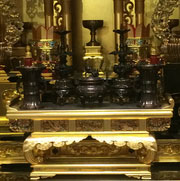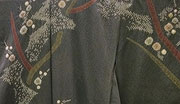Fukui and more
- Sort by
- Popularity
- Name
-
Hasami ware Hasami yaki
- Ceramic
- Nagasaki

Hasami ware (called Hasami yaki in Japanese) is a form of porcelain produced in Hasami in Nagasaki prefecture. It is a traditional handicraft that was first produced in the latter part of the Sengoku period (1467-1603) and remains popular today as…
View more
-
Nishijin brocade Nishijin ori
- Woven textiles
- Kyoto

Nishijin brocade (called Nishijin ori in Japanese) is woven silk produced in the northwestern part of Kyoto. Kamigyo ward and Kita ward cover this area of Kyoto today, but this area is called Nishijin. According to official rules, only the brocade…
View more
-
Tobe ware Tobe yaki
- Ceramic
- Ehime

Tobe ware (called Tobe yaki in Japanese) is a form of ceramic ware produced around the town of Tobe in Iyo district of Ehime prefecture. Production began in the middle of the Edo period (1603-1868) and it was registered as a traditional craft by t…
View more
-
Kyo textiles Kyo yuzen
- Dyed textiles
- Kyoto

Kyo textiles are dyed textiles made throughout Kyoto prefecture that feature a wide range of vivid colors and a technique of pictorial designs of animals, nature and daily items called yuzenmoyo. The dyeing method is very unique as artisans put gl…
View more
-
Kyo folding fans Kyo sensu
- Other crafts
- Kyoto

Kyo folding fans (called Kyo sensu in Japanese with sensu meaning folding fan) are mainly produced in Kyoto. From ancient times they have been valued as high quality art works because of their beautiful designs with gold or silver leaves or gold l…
View more
-
Echizen traditional Japanese paper Echizen washi
- Traditional Japanese paper
- Fukui

Echizen washi is a Japanese traditional paper made in the basin of the Okafuto river of the Echizen region, Fukui prefecture. Washi is made mostly from the inner bark fibers of plants such as paper mulberry, paperbush, and ganpi. Echizen washi fea…
View more
-
Mikawachi ware Mikawachi yaki
- Ceramic
- Nagasaki

Mikawachi ware (called Mikawachi yaki in Japanese) is a form of porcelain produced around the city of Sasebo, in Nagasaki prefecture. Mikawachi ware has long been regarded as a high-class item due to its simple yet eyecatching blue dye on white po…
View more
-
Tosa traditional Japanese paper Tosa washi
- Traditional Japanese paper
- Kochi

Tosa washi is a kind of traditional Japanese paper made in Kochi prefecture, both in the city of Tosa and around the town of Ino. In the past, it was used to make a holder for wallets and medicine or paper lanterns. Now it has a wide range of u…
View more
-
Echizen lacquerware Echizen shikki
- Lacquerware
- Fukui

Echizen lacquerware (called Echizen shikki in Japanese) is produced in the area around the city of Sabae in Fukui prefecture. Lacquer is at the center of life in the Echizen district of Sabae, which is known as the city of manufacturing. The notab…
View more
-
Marugame uchiwa fans Marugame uchiwa
- Other crafts
- Kagawa

Marugame uchiwa are a type of fan made in the area around the city of Marugame, Kagawa prefecture. It is believed that, in the early Edo period (1603-1868), the first Marugame uchiwa were made as souvenirs for pilgrims to the Konpira Shrine. The o…
View more
-
Kagawa lacquerware Kagawa shikki
- Lacquerware
- Kagawa

Kagawa lacquerware (called Kagawa shikki in Japanese) is produced in the area around the city of Takamatsu, Kagawa prefecture. There is a wide range of products, such as cake boxes, trays, low tables, and display cases, which are widely popular fo…
View more
-
Kyo doll Kyo ningyo
- Dolls, kokeshi
- Kyoto

Kyo dolls (called Kyo ningyo in Japanese) are produced in the city of Kyoto and its surrounding areas in Kyoto prefecture. They are made by several different artisans with their specialized expertise. There are doll head artisans as well as those …
View more
-
Echizen ware Echizen yaki
- Ceramic
- Fukui

Echizen ware (called Echizen yaki in Japanese) is a type of pottery produced in the town of Echizen, Fukui prefecture. This traditional handicraft comes from one of the Six Ancient Kilns of Japan which along with Bizen, Tamba, Tokoname, Seto, and …
View more
-
Kyo uchiwa fans Kyo uchiwa
- Other crafts
- Kyoto

Kyo uchiwa are a type of fan made in Kyoto prefecture. From the many types of Japanese traditional fans, there are three broad categories: Chinese-inspired, southern-inspired, and Korean-inspired with this craft coming from the third category. Th…
View more
-
Wakasa lacquerware Wakasa nuri
- Lacquerware
- Fukui

Wakasa lacquerware (called Wakasa-nuri in Japanese) is produced in the area around the city of Obama, Fukui prefecture. It is said to have originated in the early Edo period (1603-1868) when a craftsman serving the Obama domain (now the city of Ob…
View more
-
Echizen cutlery Echizen uchihamono
- Metal works
- Fukui

Echizen cutlery (called Echizen uchihamono in Japanese) is produced around the city of Echizen, Fukui prefecture. A double layering technique is used for knives and a rotated steel joining technique for sickles. Double layering is a forging method…
View more
-
Kyo ware/Kiyomizu ware Kyo yaki Kiyomizu yaki
- Ceramic
- Kyoto

Kyo-ware/Kiyomizu-ware (called Kyo yaki/Kiyomizu yaki in Japanese) is a type of pottery produced in the Kyoto area. Originally, Kyo-ware was a general term for all pottery produced in Kyoto, while Kiyomizu-ware specifically referred to pottery pro…
View more
-
Kyo laquerware Kyo shikki
- Lacquerware
- Kyoto

Kyo lacquerware (called Kyo shikki in Japanese) is produced in the Kyoto area. Since it developed at the same time as the tea ceremony culture, this craft possesses a wabi-sabi* quality. Kyo lacquerware has a thinner and more delicate wood grain t…
View more
-
Tosa cutlery Tosa uchihamono
- Metal works
- Kochi

Tosa cutlery (called Tosa uchihamono in Japanese) are hammer-forged blades produced in the eastern to central part of Kochi prefecture, including the town of Ino and the cities of Kami, Nankoku, Tosa, and Susaki. Kochi prefecture was once a provin…
View more
-
Kyo braided cords Kyo kumihimo
- Other textiles
- Kyoto

Kyo Braided Cords (called Kyo Kumihimo in Japanese) are produced around the cities of Kyoto and Uji, Kyoto prefecture. Since the Heian period (794-1192), this craft has been found on prestigious and sacred pieces such as Buddhist and Shinto altar …
View more
-
Ozu traditional Japanese paper Ozu washi
- Traditional Japanese paper
- Ehime

Ozu traditional Japanese paper (called Ozu washi in Japanese) is a handmade paper made in the town of Uchiko, Ehime prefecture. The history of papermaking of Ozu washi dates back to the Heian period (794-1185), and the current style of Ozu washi e…
View more
-
Kyo wood joinery Kyo sashimono
- Wood, bamboo crafts
- Kyoto

Kyo Sashimono is a kind of wood joinery produced in the prefecture of Kyoto. Sashimono is a collective name for furniture and furnishings assembled with wood joints that originates from the process of measuring with a monosashi or woodwork ruler. …
View more
-
Kyo-komon textiles Kyo komon
- Dyed textiles
- Kyoto

Kyo Komon are fine-patterned textiles produced in Kyoto prefecture. Kyoto, a historical center of dyed textiles, is renowned for its superb fabrics resulting from exceptional dyeing and stencil making. This craft has beautifully elegant colored pa…
View more
-
Kyo Buddhist altar Kyo butsudan
- Household Buddhist altars
- Kyoto

Kyo Buddhist Altars (called Kyo Butsudan in Japanese) are produced in the cities of Kyoto and Kameoka in Kyoto. Most Kyo Buddhist Altars are made for temples instead of households. They are professionally handcrafted by a number of respective expe…
View more
-
Kyo embroidery Kyo nui
- Other textiles
- Kyoto

Kyo Embroidery (called Kyo-nui) is produced in Kyoto, Kyoto prefecture. This graceful craft reflects the elegance of Kyoto's culture and requires meticulous skill. Artisans of this craft pursue absolute perfection and freely use costly silk, …
View more
-
Kyo art preservation Kyo hyogu
- Other crafts
- Kyoto

Kyoto Art Mountings, called Kyo Hyogu in Japanese,are mountings done in Kyoto prefecture. Hyogu or hyoso is a traditional technique to strengthen and preserve calligraphy works, paintings and the like with paper or cloth and adding decorations to …
View more
-
Echizen traditional chest Echizen tansu
- Wood, bamboo crafts
- Fukui

Echizen Tansu are lacquer coated chests of drawers made around Echizen City and Sabae City of Fukui Prefecture. They are mainly made of Japanese zelkova and paulownia, and decorated with iron fittings and lacquer. Japanese zelkova is a hard wood w…
View more
-
Kyo Buddhist altar equipment Kyo butsugu
- Household Buddhist altars
- Kyoto

Kyo Butsugu are Buddhist altars and altar fittings made in Kyoto. Studded with temples of various sects, Kyoto has always prospered as the center of Buddhism, inevitably leading to increasing demand for altar fittings for memorial services. 80% of…
View more
-
Wakasa agate craft Wakasa meno zaiku
- Semiprecious stone craftwork
- Fukui

Wakasa Agate Craft (Wakasa Meno Zaiku in Japanese) is agate craftwork produced around the city of Obama, Fukui prefecture. Agate has been appreciated from olden times as one of the seven treasures that decorated the sublime Buddhist paradise ment…
View more
-
Kyo dyed textiles Kyo kanoko shibori
- Dyed textiles
- Kyoto

Kyo Kanoko Shibori is a dyed textile produced in Kyoto Prefecture. Shibori is one of the tie-dye techniques that create patterns by tying the textile before dyeing so that the tied parts remain white. This particular Shibori resembles fawn spots a…
View more































































































































































































































































































